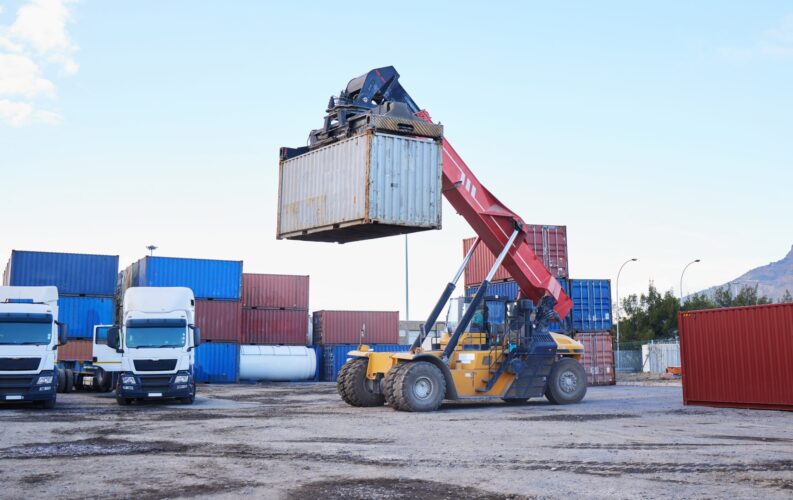Telescopic forklifts are an essential piece of equipment for many businesses, providing the user with unparalleled load capacity and the ability to lift loads to heights that cannot be reached by standard forklift models. In this blog post, we will explore what a telescopic forklift is, the benefits it can provide, how they work, and what types of attachments are available for them. We’ll also cover operator certification requirements for operators of telescopic forklifts.
What Is a Telescopic Forklift?
A telescopic forklift is a type of industrial lift truck specifically designed for use in off-road applications such as construction sites and terrain where normal lift trucks aren’t suitable. Telescopic forklifts typically have two or three arms which allow them to access greater heights than traditional lifts and with their high load capacity, they can transport heavier objects, often carrying whole pallets of goods at once.
Benefits of a Telescopic Forklift
On and Off-Road Capabilities
Telescopic forklifts are designed to operate on both flat surfaces and uneven terrain which makes them perfect for tasks like loading heavy equipment onto trucks or lifting materials up the side of a building. They are also able to navigate muddy or sandy surfaces making them ideal for land management projects like landscaping.
High Load Capacity
Telescopic forklifts can carry much heavier loads than standard lift trucks due to their large support arms and extra stability on rough terrain. The typical maximum weight capacity for most models ranges between 6,000 lbs. (2,722 kg) to 12,000 lbs. (5444 kg).
Lift Loads to Normally Unreachable Heights
The telescoping arms on a telescopic forklift allow users to reach heights far beyond those achievable with a regular lift truck. This makes them excellent tools in tasks such as loading materials onto rooftops or even placing items high up into trees! You can find certain models capable of reaching impressive heights up to 40 ft. (12 m).
Full Range of Motion
A telescopic forklift offers full range motion capabilities thanks to its adjustable height settings coupled with frontward/rearward reachability that conventional machines don’t offer. This means that not only can you lift higher than before but also move your load around obstacles more easily—all from one machine!
Choice of Attachments
Telescopic machines come equipped with an array of attachment options ranging from carriages through to truss booms, buckets, and pallet forks giving users the flexibility needed when taking on various jobs in different environments and conditions. Common attachment options include:
- Carriage: This is a frame-like structure that attaches to the back of the machine, allowing it to hold and transport materials such as pallets, drums, and pipes. A variety of sizes are available depending on the size and capacity of the forklift being used.
- Bucket: This attachment can be used to scoop up and carry a variety of materials such as sand, gravel, soil, and snow. The size of the bucket attachment will vary depending on the size of the machine it is being attached to.
- Truss Boom: This long, extendable arm is used to lift and move large, bulky items that cannot be lifted with the carriage attachment. The truss boom can also be used to move materials from one side of a room or area to another.
- Pallet Fork: This attachment is used to move pallets and other large, heavy items. It features two long forks that are inserted into the bottom of a pallet to lift it off of the ground. The forks can then be adjusted in length to fit different depths of pallets.
- Man Basket: This attachment is used to lift and transport workers safely up and down from elevated work areas. It attaches to the boom of a telescopic forklift and can be raised or lowered with the use of controls located in the cab of the machine.
How Telescopic Forklifts Work?
The typical structure of the average telescoping machine consists of a base support frame which connects all four corners allowing each corner arm to extend independently while being securely held by four support arms located beneath each corner joint—these small time-saving adjustments help work productivity drastically reducing downtime throughout busy workplaces where speed is key!
Internally these units feature hydraulic cylinders controlled by levers connected directly to either side of the boom arm, allowing you precise control over load height as well as travel direction. This makes precise placement easy when dealing with delicate items or valuable cargo!
Telescopic Forklift Certification Requirements
Due to their increased complexity compared to other lifts, it is important that any operator utilizing one obtain proper certification before attempting any sort of operation onsite. Failure to comply could result not only in potential injury but also liability issues, so ensure your workplace remains compliant by having employees complete forklift training programs provided by certified dealerships!
Contact NovaLift Equipment, Inc. for All Your Forklift Needs in Toronto
NovaLift Equipment, Inc. specializes in sales and servicing of new and used telescoping lifts from leading brands, as well as complementary products such as remote controls batteries and straps. Get in touch today to learn more about our forklifts and their accessories.


